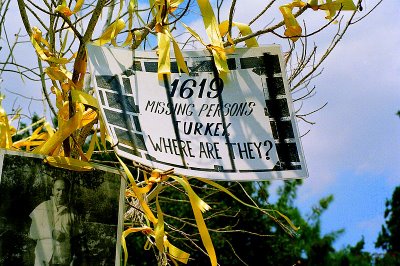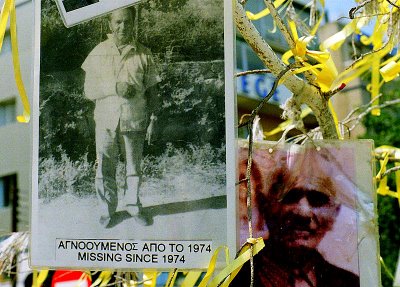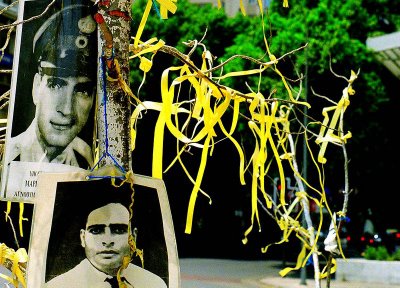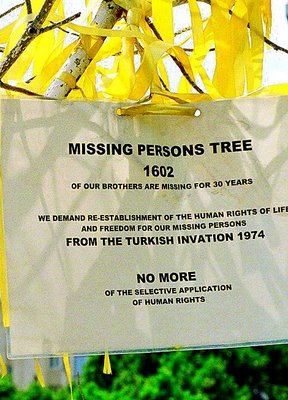Photo Essay: Missing in Plain Sight
- Hundreds of Cypriots vanished some thirty years ago. Most of them were casualties of the 1974 war, but their bodies have never been recovered. In many cases, eyewitnesses saw them die; but that hasn’t stopped persistent rumors on the Greek side of the island that they’re all still secretly being held in Turkish prisons. I heard a story about one young Greek Cypriot woman who had lost her husband in 1974 and never remarried, because she believed that he was still alive somewhere in Turkey. Now she’s in her fifties; and her only son is in his thirties. All those years spent waiting.
Some Cypriot prisoners of war were transported to Turkey during the conflict in 1974. After the cease fire that August, the Cypriots detained in Turkey were repatriated in October and November under the auspices of the International Committee of the Red Cross, which concluded at the time that there were no Cypriot prisoners left in Turkey. Yet the myth that some 1600 Greek Cypriots are still languishing in Turkish prisons hasn’t lost its propoganda value to this day. The images in this photo essay were taken of a political art installation that stood across the street from the Greek Cypriot town hall in Nicosia throughout the summer of 2005.
As a New Yorker, I found these images disturbingly familiar. Similar family photos had hung from lamp posts and chain link fences in Manhattan for months after the terrorist attacks on September 11th, 2001. But in New York, most of the families had accepted after the first few days that their missing family members were dead. Evidently, based on the messages in this photo essay, some Greek Cypriots weren’t willing to accept that after 31 years.
- Even the numbers have been politicized. First, none of the messages on this sidewalk shrine refer to the Turkish Cypriots who are still missing. When the authorities on the Greek side speak about this issue, they also only mention the Greek Cypriots who are missing. But how many Greek Cypriots? In the two images that bookend this photo essay, the number of missing Greek Cypriots is given as either 1619 or 1602. Both figures are very far from the official count.
The confusion dates back more than thirty years. Initially, 1619 Greek Cypriots were listed as missing in 1974, but that number was quickly revised to 1602. The estimates were revised several more times, because some names on the list were duplicates; while the human remains of some of the others had been discovered. The final count for the missing Greek Cypriots was 1493. The remains of 13 of them have been identified in recent years. So while I was in Cyprus in the summer of 2005, there were 1480 Greek Cypriots who were still on the official missing persons list.
Among the 501 Turkish Cypriots who were still on that list, about 200—or roughly 40 percent of them—had been missing since the inter-communal strife that reigned on the island from 1963 until 1964. The number of missing Greek Cypriots from that period is much lower proportionately. Only about 40 of the Greek Cypriots who were still missing had disappeared during that time.
- In fact, many of the missing Cypriots aren’t really missing at all. Eyewitnesses have testified about where a number of them were buried; and the authorities on both sides know where to find some of the most notorious mass graves. But Cypriots have elevated foot-dragging to a fine art—until events force them to act. While I was there, the Turkish Cypriots exhumed 24 bodies from burial sites in the north that had been identified long ago. The exhumations were done in haste, because the sites were about to be developed.
The task of identifying the remains of the missing Cypriots has long been entrusted to the Committe on Missing Persons, which was established in 1981. The committee includes one member nominated by each of the Greek and Turkish Cypriot communities; and a third member nominated by the International Committee of the Red Cross, and appointed by the United Nations Secretary General. By the summer of 2005, the committee had drafted a plan to exhume all of the known burial places and build a laboratory within the buffer zone to identify the remains. This effort is one of the confidence building measures that have become the focus of diplomacy on Cyprus in recent years—in lieu of any real progress towards a final, definitive peace plan that would reunite the island.
Meanwhile, the missing have assumed a different political hue on the Turkish side of the island, where some people think of the missing Turkish Cypriots as martyrs. After all, the separatist elements among the Turkish Cypriots won their goal—taskim, or the partition of the island between Greek and Turkish zones—so it’s much easier for them to accept their losses. But it’s far more psychologically stressful for the Greek Cypriots, who live every day with reminders of their divided homeland, to accept that nearly 1500 of their missing compatriots died in vain.
tCr










1 Comments:
we have a lot of witnesses that say that they ahve been in turkish prisons.many of the other greeks there never returned.ask turkesy where they have them or we will invate kai kill all turks.
Post a Comment
<< Back to tCr Home